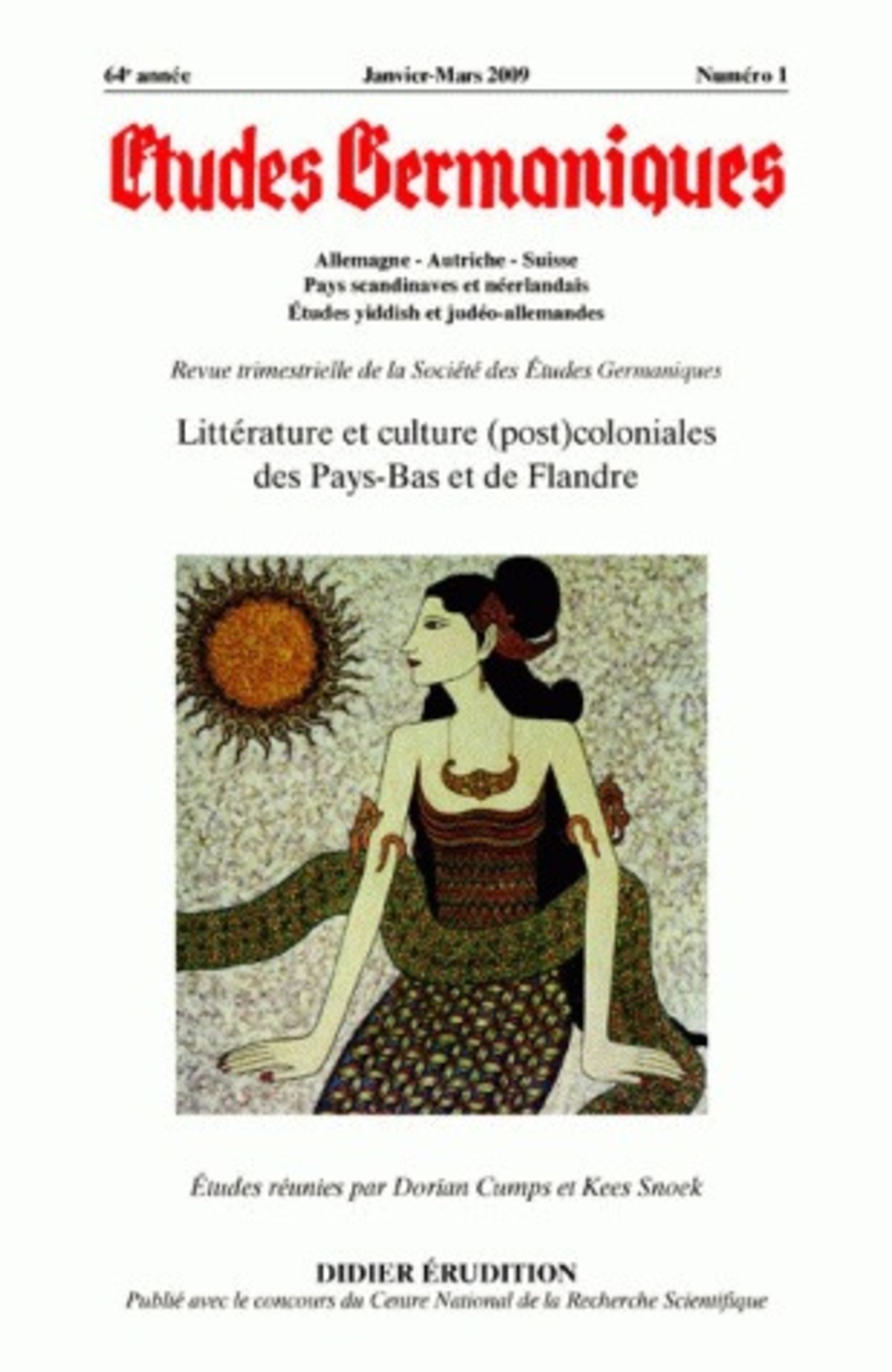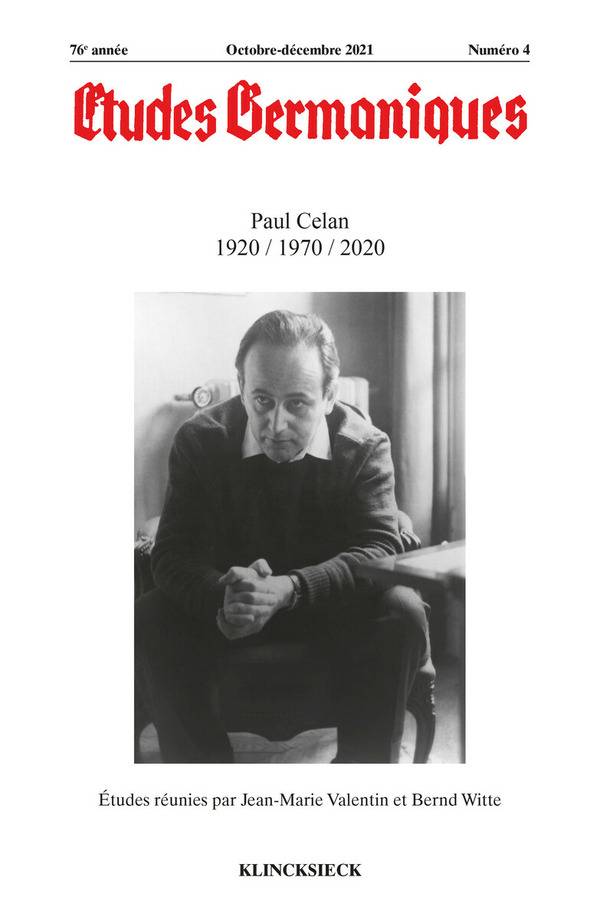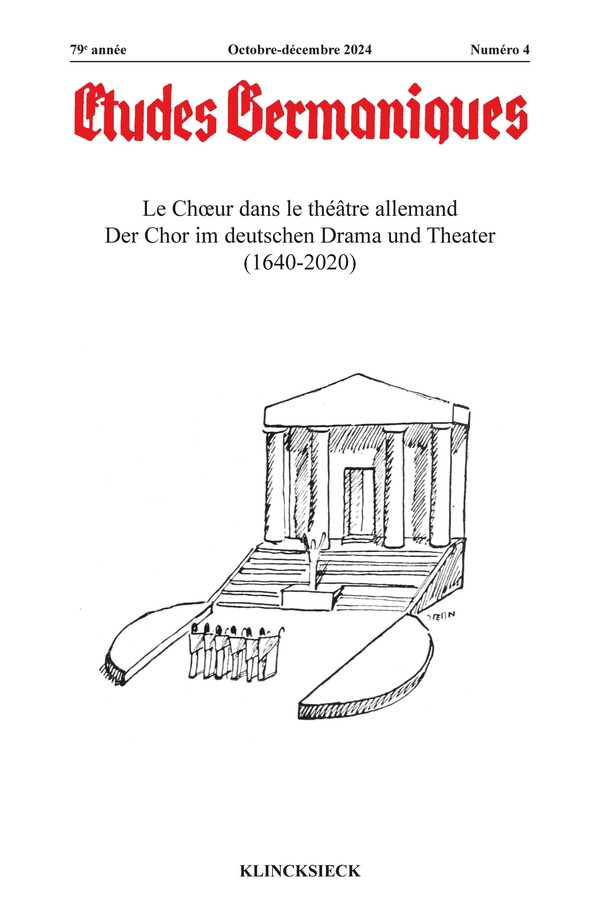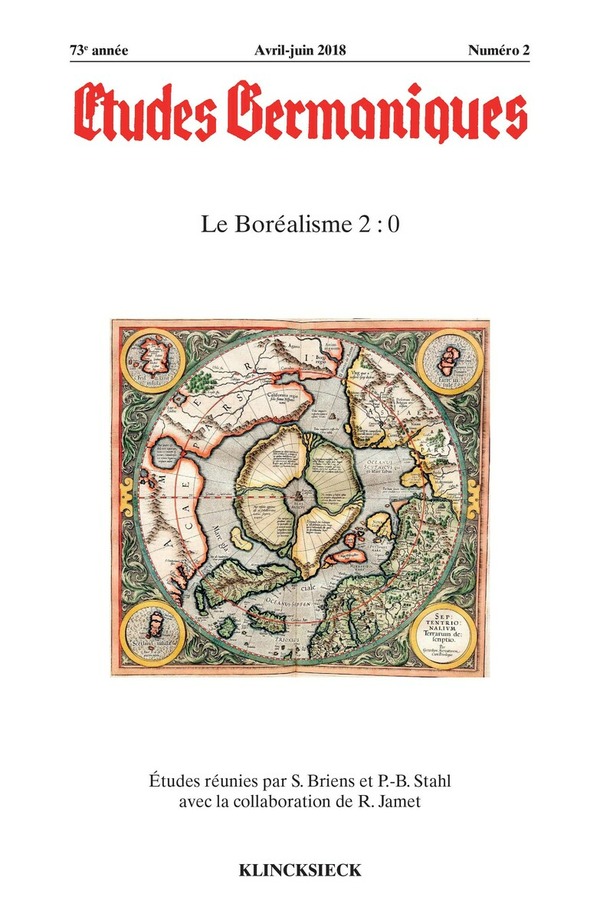Études germaniques - N°1/2009
Littérature et culture (post)coloniales des Pays-Bas et de Flandre

- 176 pages
- Livre broché
- 15 x 23 cm
- Études germaniques
- Parution : 25/05/2009
- CLIL : 3146
- EAN13 : 9782252037010
- Code distributeur : 34401
Présentation
Luc BERGMANS, Le roman Max Havelaar de Multatuli, un pusaka
The novel Max Havelaar, written by Multatuli (the penname of Edward Douwes Dekker) in 1860, has always been perceived as, above all, denouncing the oppression suffered by the people of the Dutch East Indies. Because of this perception, the second objective, explicitly mentioned by the author, namely creating a literary pusaka or heirloom, has been largely neglected by literary criticism. The present article will attempt to remedy this situation by analysing Max Havelaar firstly as a written family heirloom that closely connects the suffering of « the Javanese » with the suffering of the author and his loved ones and, secondly, as a weapon that has the power to protect and avenge a community. Max Havelaar has a double orientation : towards the past, in that the book was conceived to preserve memories of shared suffering ; and towards the future, in that the novel constitutes an appeal to act upon that suffering. The structure of Max Havelaar is at least partly determined by its role as an heirloom. Hence the literary devices employed by Multatuli deserve comparison with the interlacing and alloying which characterise the work of weavers and goldsmiths who create artistic pusakas. The penname, Multatuli, contains a pun on this masterly type of mixing.
Multatuli's Max Havelaar wordt telkens opnieuw gelezen als een aanklacht tegen de wantoestanden in het koloniale beheer van Nederlands-Indië. Daarbij blijft de andere expliciete doelstelling van de roman, namelijk het scheppen van een poesaka (erfstuk) veelal onderbelicht. Deze bijdrage poogt dit te verhelpen door het werk te interpreteren als een familiedocument, waarin het lijden van de auteur en zijn gezin met dat van de onderdrukte Javaan in nauw verband wordt gebracht, maar tevens als wapen dat een gemeenschap beschermen en wreken kan. Het erfstuk Max Havelaar heeft een dubbele oriëntatie : naar het verleden toe, als herinnering aan lijden, en naar de toekomst toe, als oproep om op dat lijden te reageren. De poesaka-functie van het boek heeft tenslotte ook gevolgen voor de structuur van de roman. Zo verdient een aantal van de literaire procédés, die Multatuli aanwendt, vergeleken te worden met de verstrengeling en versmelting die door wevers en smeden worden toegepast bij het vervaardigen van kunstvoorwerpen, die als poesaka's worden overgeleverd. Naar deze meesterlijke vorm van vermenging verwijst ook de naam Multatuli.
Ingrid WASIAK, P.A. Daum, un naturaliste aux Indes néerlandaises Orientales
In 1879, Dutch author Paulus Adrianus Daum (1850-1898) left The Hague for the Dutch East Indies. Besides being an influential journalist, Daum was also an important novelist of tempo doeloe, La Belle Époque of the Dutch East Indies. This article explores the specificity of Daum, in comparison with contemporary authors such as Louis Couperus, Marcellus Emants and Lodewijk van Deyssel. In which respect can we regard his novels as naturalistic ?
De Nederlandse schrijver Paulus Adrianus Daum (1850-1898) verliet in 1879 Den Haag om zijn heil te zoeken in Nederlands-Indië. Hij werd er niet alleen een invloedrijk journalist, maar ook een belangrijk romancier die zijn stempel heeft gezet op tempo doeloe, de « Belle Époque » van Nederlands-Indië. In dit artikel wordt nagegaan in hoeverre P.A. Daum beschouwd kan worden als een « unicum » in de Nederlandse letteren en in welk opzicht zijn romans te beschouwen zijn als naturalistisch, in vergelijking met werk van bij voorbeeld Louis Couperus, Marcellus Emants of Lodewijk van Deyssel.
Thomas BEAUFILS, Transposition et réinvention des mythes épico-purâniques et javanais dans De kist de Maria Dermoût
Maria Dermoût is not truly a Dutch author. This observation results from our analysis of De kist (1958). Maria Dermoût was born in Java in 1888 and spent most of her life in the Dutch East Indies. Even though she wrote in Dutch, her cultural references for De kist are purely Javanese. This book is deeply imbued with Indian and Javanese myths, some of which she rewrote. De kist is a kind of palimpsest in which literature and cultural references are superimposed, as this paper proposes to decrypt.
Maria Dermoût is geen authentieke Nederlandse schrijfster. Dat komt in ieder geval naar voren uit onze analyse van het boek De kist. Ze is in 1888 geboren op Java en heeft een groot deel van haar leven doorgebracht in Nederlands-Indië. Ze schrijft dan wel in het Nederlands, maar haar culturele verwijzingen in dit boek zijn uitsluitend Javaans, waardoor het werk diep doordrongen is van Indiase en Javaanse mythen. De kist is een soort palimpsest waarin verschillende lagen van literaire en culturele verwijzingen elkaar overlappen.
Stéphanie LORIAUX, Chercher l'autre, devenir soi La problématique identitaire dans la littérature féminine liée à la décolonisation des Indes néerlandaises Orientales
In this paper, we mean to analyse the theme of the identity problematic which ensues from the decolonisation of the Dutch East Indies in the work of the women writers Hella S. Haasse and Marion Bloem. In their postcolonial novels, they concentrate on the identity quest from which both former Dutch colonials and Indo-Europeans (of mixed Indonesian-European blood) suffer. In Haasse's work, the identity conflict arises from the failed digestion of the colonial past, i.e. from the denial of its impact on one's life. Marion Bloem concentrates on the schizophrenia of the second generation of Indo-Europeans who live between two cultures without completely acquiring either one.
Dit artikel concentreert zich op de behandeling van de identiteitsproblematiek met betrekking tot de dekolonisatie van Nederlands-Indië bij de schrijfsters Hella S. Haasse en Marion Bloem die in hun postkoloniale werken de zoektocht naar identiteit van Nederlandse oud-kolonisten dan wel Indische Nederlanders aan het licht brengen. Bij Hella Haasse vloeit het identiteitsconflict voort uit de mislukte verwerking van het koloniale verleden, d.w.z. uit de ontkenning van de impact ervan op het latere leven. Bij Marion Bloem staat de schizofrenie van de tweede generatie Indische Nederlanders centraal die tussen twee vaderlanden leven en zich geen van beide eigen kunnen maken.
Michiel van KEMPEN, « Laisse-moi te montrer mon pays ! » Le regard du touriste dans les écrits des Indes néerlandaises Occidentales
Numerous texts by Surinamese, Dutch-Antillean and Aruban writers deal with the Middle Passage (the forced "migration" from Africa to the New World) and the life-long enslavement of millions of Africans. Strangely enough, in the very same period slavery was flourishing, tourism came into being. The exotic other became an object of western interest. What did the western world bring about in the head of the other ? In many Caribbean texts the tourist's view is visible : the tension between the own view and the view of the other comes to the surface, sometimes explicitly, sometimes more covertly, at times in the ways language is used. For Caribbean writers, the struggle with literary imagination has eradicated the tourist from their conscience. On the basis of texts from the 18th through the 21st century, this paper tries to unravel the tourist's view, first in the Histoire d'une franco-indienne ; écrite par elle-même (1787), subsequently in texts by R. Dobru, Albert Helman, Cola Debrot, Trefossa, Sonia Garmers, Denis Henriquez and Chitra Gajadin.
Talloze teksten van Surinaamse, Antilliaanse en Arubaanse schrijvers hebben de Middle Passage (de gedwongen migratie van Afrika naar de Nieuwe Wereld) en de levenslange knechting van miljoenen tijdens de slavernij gethematiseerd. Bizar genoeg komt in dezelfde tijd dat de plantagemaatschappij floreerde, het toerisme op. De exotische ander wordt interessant. Wat heeft de westerling in het hoofd van de ander teweeggebracht ? In veel Caraïbische teksten wordt de toeristenblik zichtbaar : de spanning tussen eigen en andermans blik komt aan de oppervlakte, soms expliciet, soms meer verborgen, soms in het taalgebruik. De worsteling met de literaire verbeelding is voor Caraïbische schrijvers dan ook vooral een zaak geweest van het verdrijven van de toerist uit het bewustzijn. Aan de hand van teksten uit de 18de tot en met de 21ste eeuw wordt geprobeerd die toeristenblik te ontrafelen, eerst de Histoire d'une franco-indienne ; écrite par elle-même (1787) en verder teksten van R. Dobru, Albert Helman, Cola Debrot, Trefossa, Sonia Garmers, Denis Henriquez en Chitra Gajadin.
Kim ANDRINGA, Boeli van Leeuwen et les damnés de la terre
In the works of Boeli van Leeuwen (Curaçao), father-son relations and faith are the main themes, an essential element of which is the wretched of the earth. The existential quest of the earliest protagonists is rather self-centred, but the later works show an increasing interest in social outcasts, erected by Van Leeuwen as examples of authenticity. Through solidarity with the poor one can come to terms with an indifferent God and a purposeless existence.
In het oeuvre van Boeli van Leeuwen (Curaçao) zijn vader-zoonverhoudingen en geloof de hoofdthema's. De verworpenen nemen hierin een essentiële plaats in. De existentiële zoektocht van de vroegste hoofdpersonen is vrij egocentrisch, maar in het latere werk komt er oog voor de maatschappelijke verschoppelingen die Van Leeuwen tot een toonbeeld van authenticiteit verheft. Door solidariteit met de armen kan men afrekenen met een onverschillige God en een zinloos bestaan.
Julien VERMEULEN, La prose néerlandophone sur l'Afrique centrale et la littérature orale africaine. Stratégies intertextuelles
Since 1880 about 250 Dutch travelogues and novels have been published on Central Africa. Flemish literary critics often referred to the prejudices the authors showed with respect to the African people they portrayed. Needless to mention that the ideals of cultural evolutionism often influenced the narrative plots and the literary characters. Some novelists however also paid attention to a wide range of African cultural data and even integrated a number of African oral genres in their works. In this analysis we shall focus on the identity of the African ethnicities, the oral genres that have been integrated in Flemish colonial prose, the inter-textual shifts between source text and target text as well as the intra-textual functions of the oral extracts that have been quoted.
Vanaf 1880 werden er in het Nederlands ongeveer 250 literaire werken gepu-bliceerd die hun inspiratie vonden in Centraal-Afrika. De literaire kritiek wees vaak op de discriminerende beeldvorming in deze koloniale reisverhalen en fictie. Het cultureel evolutionisme en de vooruitgangsideologie vertekenden inderdaad soms het mensbeeld dat in deze literatuur uitgebeeld werd. Enkele Nederlandstalige auteurs brachten echter ook aandacht op voor bepaalde aspecten van de Afrikaanse culturen en orale literatuur. In deze bijdrage onderzoeken we hoe de Afrikaanse orale genres in het proza van auteurs als J. Bergeyck, A. Claeys, J.M. Elsing en J. Geeraerts verwerkt worden. Deze analyse besteedt aandacht aan de identiteit van de beschreven etnieën, het precieze karakter van de orale genres, de intertekstuele verschuivingen tussen brontekst en doeltekst en de intratekstuele functies van de geciteerde fragmenten.
Eep FRANCKEN et Olf PRAAMSTRA, La muse de Jean du Cap. La littérature néerlandaise d'Afrique du Sud
Traditionally, Dutch colonial and postcolonial literature is regarded as consisting of three major branches, namely Dutch literature of the former Dutch East Indies (now Indonesia), the Dutch Antilles and Surinam. However, the authors of this article argue that in this respect a fourth branch has been undeservedly neglected – Dutch literature from South Africa. Dutch language and literature were highly important in South African cultural life until the official recognition of the Afrikaans language in 1925. In the nineteenth century hundreds of Dutch books and periodicals appeared, all intended for South African readers, and there was a flourishing Dutch literary culture. In Dutch literary history, however, this South African connection has always been relatively unknown. This article gives an overview of South African Dutch literature, and describes its position in Afrikaans literary history. As a foretaste, three authors are introduced : one from the nineteenth and two from the twentieth century.
Van oudsher bestaat er een driedeling binnen de Nederlandse koloniale en postkoloniale letterkunde. Men onderscheidt drie hoofdstromen : de Indische literatuur, die hoort bij het voormalige Nederlands-Indië (nu Indonesië), de Surinaamse literatuur en de literatuur van de Nederlandse Antillen. Maar volgens de auteurs van dit artikel ziet men op deze manier een vierde literatuur over het hoofd : de Nederlandse literatuur van Zuid-Afrika. Tot de officiële erkenning van het Afrikaans in 1925 waren de Nederlandse taal en de Nederlandse literatuur in Zuid-Afrika van het grootste belang. In de negentiende eeuw verschenen er honderden boeken en tijdschriften in het Nederlands, bestemd voor Zuid-Afrikaanse lezers. Het literaire leven bloeide. Maar in de geschiedschrijving van de Nederlandse literatuur is over dit alles nauwelijks iets te vinden. Dit artikel geeft van de Zuid-Afrikaanse Nederlandse literatuur een kort overzicht en gaat ook in op haar relatie tot de Afrikaanse literatuurgeschiedenis. Bij wijze van voorproefje geeft het artikel ten slotte een introductie van drie schrijvers : een uit de negentiende en twee uit de twintigste eeuw.
Kees SNOEK, L'Île au rhum et Nuits irlandaises de S. Vestdijk : deux romans coloniaux sur la perte d'une illusion
S. Vestdijk was a prolific writer of historical and contemporary novels. In all his novels themes characteristic of his writing come to the fore, such as the loyalty to one's past, the longing for a beloved woman and the reversibility of loyalty and treason. We discuss two historical novels of Vestdijk which are situated in a colonial environment : Rumeiland (1940) and Iersche nachten (1944). Vestdijk's Marxist colleague Theun de Vries opined that the colonial situation of Jamaica was insufficiently exposed in Rumeiland. He did, however, praise the image Vestdijk drew of the social effects of colonialism in nineteenth-century Ireland. We argue that Vestdijk did present a penetrative picture of colonial society in Rumeiland, both in his descriptions and in certain symbolical representations. Contemporary critics were so focused upon the central romantic story that they paid but little attention to the social aspects of the novel.
S. Vestdijk was een productief schrijver van historische en contemporaine romans. In al zijn romans komen hem typerende thema's naar voren zoals trouw aan het verleden, het verlangen naar een geliefde vrouw en de omkeerbaarheid van trouw en verraad. Wij bespreken twee historische romans van Vestdijk die gesitueerd zijn in een koloniale omgeving : Rumeiland (1940) en Iersche nachten (1944). Vestdijks marxistische collega Theun de Vries meende dat de koloniale situatie onvoldoende werd belicht in het op Jamaica spelende Rumeiland. Hij was echter vol lof over het beeld dat Vestdijk gaf van de sociale gevolgen van het kolonialisme in het negentiende-eeuwse Ierland. Wij betogen dat Vestdijk ook in Rumeiland een scherp beeld heeft gegeven van de koloniale samenleving, zowel in zijn beschrijvingen als in symbolische representaties. Gefixeerd als zij was op de romantische hoofdlijn van het verhaal in Rumeiland, heeft de contemporaine kritiek hier weinig oog voor gehad.
Jean-Luc GOUIN, Ataraxie au tréfonds de l'ivresse dionysienne. Hegel ou de la Vernunft comme sémaphore du réel
The important Hegelian thesis on the integral, and therefore absolute, rationality of being is well known. Consequently, it seems to be useless to keep on talking about the Hegel of Logic, for example, as opposed to the Hegel of Politics, of History, of Nature, of Æsthetics as well as the Hegel of the Religious. Such « regional » logics are ultimately reducible to the one and same fundamental structure of sense and that of « the » sense. This text aims precisely at providing convincing evidence to the hypo-thesis of the basic intelligibility of the real as residing in the so-called SNRR Gyroscope (or matrix system) Subject – Negativity – Result – Reconciliation.
Hegels große These über die vollständige Vernunftgemäßheit des Seins, die dadurch absolute Rationalität wird, ist bekannt. Es ist also nicht nötig, den Hegel der Logik zu thematisieren, so als handle es sich auch um den Hegel des Politischen, der Geschichte, der Natur, der Ästhetik oder des Religiösen. Die « regionalen » Logiken verweisen aus Sicht eines Philosophen auf dieselbe Grundstruktur des Sinnes. Diese Studie wählt die Hypothese der Intelligibilität des Reellen (des Wirklichen) als innewohnend in dem, das der Autor seinerseits das Gyroskop SNRV (oder Sinn-Matrix) nennen wird : Subjekt – Negativität – Resultat – Versöhnung.
Biographies Contributeurs
Jean-Marie Valentin
Jean-Marie Valentin est professeur à la Sorbonne, titulaire de la chaire d'histoire culturelle du monde germanique de l'Institut universitaire de France. Membre du Haut Conseil culturel franco-allemand et de la Deutsche Akademie f ür Sprache und Dichtung, il dirige aux éditions Klincksieck la collection Germanistique. Il a dirigé, entre autres, l'édition des Écrits sur le théâtre de Bertolt Brecht dans la « Bibliothèque de la Pléiade ».




